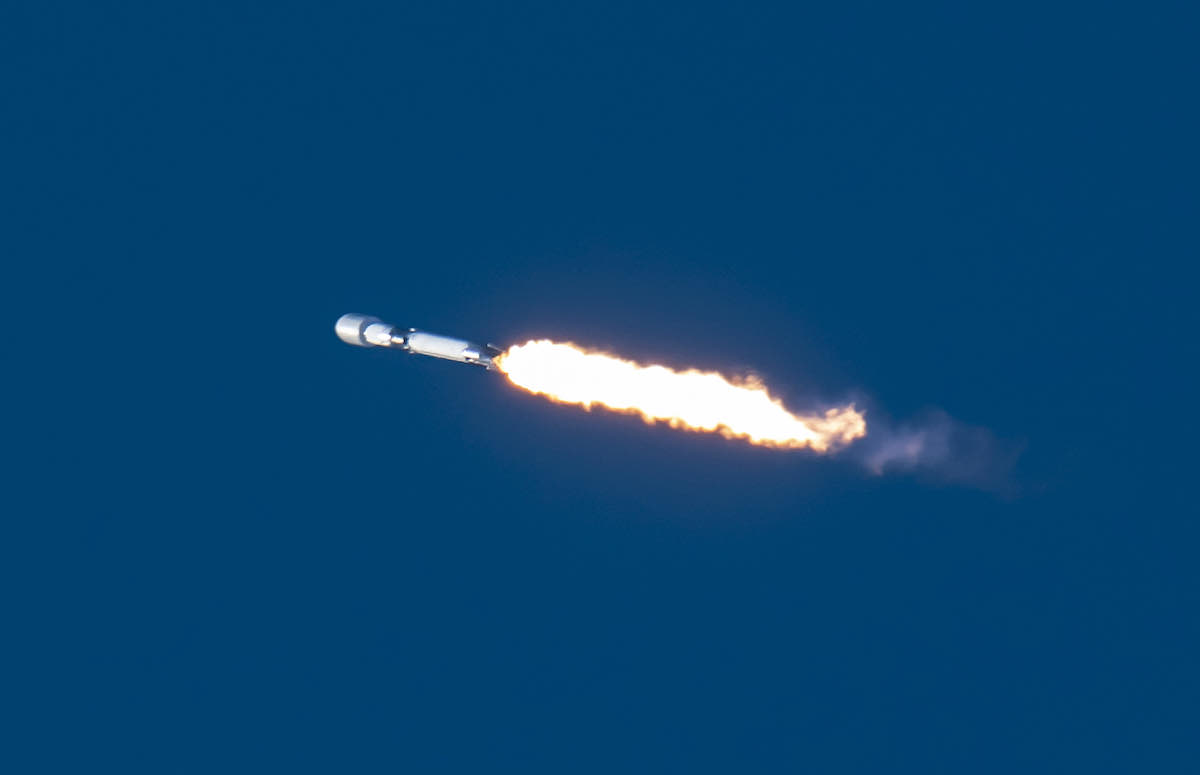
SpaceX launched a Falcon 9 rocket with a batch of 50 more Starlink internet satellites Friday from the Central Coast of California, the company’s second Starlink mission in four days. Two more Starlink launches are scheduled from Florida in the first half of March.
The 50 new Starlink satellites took off from Space Launch Complex 4-East at Vandenberg Space Force Base at 9:12:10 a.m. PST (12:12:10 p.m. EST; 1712:10 GMT) Friday, riding a Falcon 9 rocket into a clear blue sky from the West Coast spaceport.
The Falcon 9 rocket’s nine Merlin engines, generating 1.7 million pounds of thrust, steered the launcher southeast from Vandenberg on a track along the coast of Southern California. The first stage shut down and separated two-and-a-half minutes into the mission to begin a descent back toward SpaceX’s drone ship “Of Course I Still Love You” parked in the Pacific Ocean east of Baja California.
The booster re-entered the atmosphere as the Falcon 9’s upper stage took over the mission, using its single Merlin powerplant to guide the 50 Starlink satellites into a preliminary transfer orbit.
The first stage nailed its landing on the drone ship, completing its fourth trip to space and the 108th recovery of a Falcon booster since SpaceX’s first landing in December 2015.
The upper stage coasted halfway around the world before reigniting its engine over the Indian Ocean for a brief one-second firing the nudge the 50 Starlink satellites into a near-circular orbit about 196 miles (316 kilometers) above Earth.
SpaceX’s Falcon 9 rocket has lifted off from Vandenberg Space Force Base, powered by nine Merlin engines to climb into space with 50 Starlink internet satellites. https://t.co/3lzXK6Uj8m pic.twitter.com/JAyxIYYzpm
— Spaceflight Now (@SpaceflightNow) February 25, 2022
A few minutes later, more than an hour after launch, retention rods released to allow the 50 flat-packed Starlink satellites to fly free of the Falcon 9 rocket. SpaceX declared the launch a success, the 38th Falcon 9 mission dedicated to deploying satellites for the Starlink internet network.
The mission marked the 150th flight of a Falcon 1, Falcon 9, or Falcon Heavy rocket since SpaceX debuted its launcher family in 2006. It was the 21st SpaceX launch from Vandenberg, a military spaceport located on California’s rugged Central Coast between Los Angeles and San Francisco.
The launch was also the second this week to carry Starlink satellites into orbit, following the liftoff of a Falcon 9 rocket Monday from Cape Canaveral with 46 of the privately-built broadband relay stations.
SpaceX has launched 2,187 Starlink internet satellites to date, some of which have failed or been decommissioned. A tabulation maintained by Jonathan McDowell, an astrophysicist and expert tracker of spaceflight activity, suggests SpaceX currently has 1,945 working satellites in orbit.
That makes SpaceX the owner of the world’s largest fleet of satellites,.
Each Starlink spacecraft weighs about a quarter-ton, and is fitted with communications antennas, a solar panel, laser inter-satellite links, and krypton-fueled ion thrusters for orbital maneuvers.
The Starlink network will number roughly 4,400 satellites when SpaceX is done building out the first phase of the network, spread among five different orbital “shells” at different altitudes and inclinations. SpaceX, founded and led by Elon Musk, has signaled it eventually intends to launch as many as 42,000 satellites.
The network beams high-speed, low-latency internet signals around the world, reaching consumers, underserved communities, and other potential users like the U.S. military. SpaceX says the Starlink network recently “went live” in Brazil in Bulgaria, and is now available to consumers in 29 global markets.
Starlink deploy confirmed.
The 50 Starlink internet satellites have separated from SpaceX’s Falcon 9 rocket after launching from California.
This brings the total number of Starlink craft launched to date to 2,187 satellites.https://t.co/3lzXK6Uj8m pic.twitter.com/hpFim9QPI9
— Spaceflight Now (@SpaceflightNow) February 25, 2022
The 50 Starlink satellites will use their ion engines to reach an orbit at an altitude of 335 miles (540 kilometers) and an inclination of 53.2 degrees to the equator, where they will begin commercial service.
The launch Friday was SpaceX’s eight mission of the year, and the second from Vandenberg. SpaceX aims to launch at an average pace of one flight per week this year, with nearly one launch per mont planned at the California spaceport in 2022, following a dearth of SpaceX missions from Vandenberg since the start of 2019.
SpaceX’s next two missions are slated to take off from Florida. A Falcon 9 rocket is set for launch next Thursday, March 3, from pad 39A at Kennedy Space Center with another batch of Starlink satellites. Another Falcon 9 is scheduled to blast off March 8 from pad 40 at Cape Canaveral Space Force Station with more Starlink satellites.
Email the author.
Follow Stephen Clark on Twitter: @StephenClark1.
